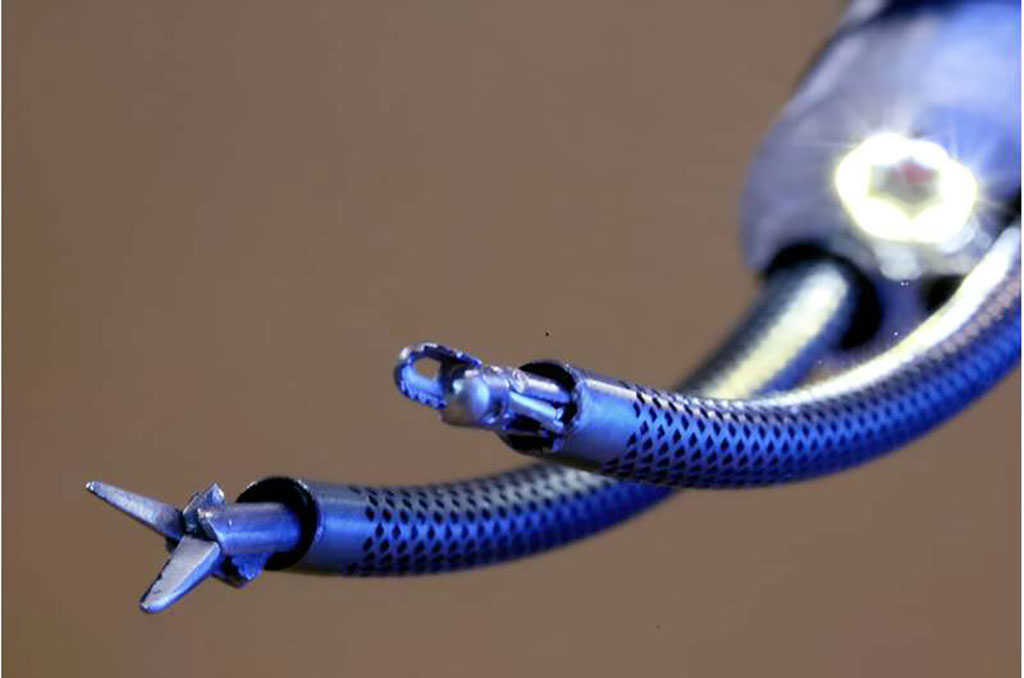Joystick-Controlled Neurosurgical Robot Could Revolutionize Complex Brain Surgeries 
|
By HospiMedica International staff writers Posted on 13 Oct 2023 |

Robots are a familiar sight in operating rooms nowadays, aiding surgeons in performing minimally invasive procedures. However, their use in neurosurgery has been more restricted. While robots are proficient at simpler tasks like placing an electrode, complex operations like tumor removal have typically required surgeons to expose the brain through the skull. Now, scientists have designed a prototype two-armed, joystick-controlled neurosurgical robot that has the potential to transform complex brain surgeries, such as excising tumors.
The robot developed by engineers at Children's Hospital Boston (Boston, MA, USA) skillfully executed a range of two-handed neurosurgical tasks required for tumor removal and reducing tumor size in lab-created models. The crowning achievement was the endoscopic extraction of a pineal tumor from the core of a 3D model brain, based on imaging data from an infant patient. During the tests, neurosurgeons found that the dual-armed robot allowed them to complete delicate operations faster than using traditional manual instruments, all while avoiding the compression of adjacent brain tissue.
The robot's impressive performance indicates that it could be used for excising larger, vascularized tumors that currently necessitate traditional open surgery methods. Looking beyond tumor and cyst removal, the engineers also see the robot's potential in treating conditions like hydrocephalus and in performing transurethral endoscopic procedures for conditions like bladder tumors and benign prostatic enlargement. The engineers are optimistic that a well-established medical device company will eventually take this dual-armed robot to human trials.
"The brain is the last part of the body where tool access and articulation are poor," said Pierre Dupont, Ph.D., chief of Pediatric Cardiac Bioengineering at Boston Children's, who developed the robot. "Neurosurgeons who have seen the robot all say, 'This is what we need.' We want to devise a business model that will work for hospitals, and then go back and refine the robot to fit the model."
Related Links:
Children's Hospital Boston
Latest Surgical Techniques News
- New Procedure Found Safe and Effective for Patients Undergoing Transcatheter Mitral Valve Replacement
- No-Touch Vein Harvesting Reduces Graft Failure Risk for Heart Bypass Patients
- DNA Origami Improves Imaging of Dense Pancreatic Tissue for Cancer Detection and Treatment
- Pioneering Sutureless Coronary Bypass Technology to Eliminate Open-Chest Procedures
- Intravascular Imaging for Guiding Stent Implantation Ensures Safer Stenting Procedures
- World's First AI Surgical Guidance Platform Allows Surgeons to Measure Success in Real-Time
- AI-Generated Synthetic Scarred Hearts Aid Atrial Fibrillation Treatment
- New Class of Bioadhesives to Connect Human Tissues to Long-Term Medical Implants
- New Transcatheter Valve Found Safe and Effective for Treating Aortic Regurgitation
- Minimally Invasive Valve Repair Reduces Hospitalizations in Severe Tricuspid Regurgitation Patients
- Tiny Robotic Tools Powered by Magnetic Fields to Enable Minimally Invasive Brain Surgery
- Magnetic Tweezers Make Robotic Surgery Safer and More Precise
- AI-Powered Surgical Planning Tool Improves Pre-Op Planning
- Novel Sensing System Restores Missing Sense of Touch in Minimally Invasive Surgery
- Headset-Based AR Navigation System Improves EVD Placement
- Higher Electrode Density Improves Epilepsy Surgery by Pinpointing Where Seizures Begin
Channels
Critical Care
view channel
AI Interpretability Tool for Photographed ECG Images Offers Pixel-Level Precision
The electrocardiogram (ECG) is a crucial diagnostic tool in modern medicine, used to detect heart conditions such as arrhythmias and structural abnormalities. Every year, millions of ECGs are performed... Read more
AI-ECG Tools Can Identify Heart Muscle Weakness in Women Before Pregnancy
Each year, some mothers die from heart-related issues after childbirth, with many of these deaths being preventable. Screening for heart weakness before pregnancy could be crucial in identifying women... Read morePatient Care
view channel
Portable Biosensor Platform to Reduce Hospital-Acquired Infections
Approximately 4 million patients in the European Union acquire healthcare-associated infections (HAIs) or nosocomial infections each year, with around 37,000 deaths directly resulting from these infections,... Read moreFirst-Of-Its-Kind Portable Germicidal Light Technology Disinfects High-Touch Clinical Surfaces in Seconds
Reducing healthcare-acquired infections (HAIs) remains a pressing issue within global healthcare systems. In the United States alone, 1.7 million patients contract HAIs annually, leading to approximately... Read more
Surgical Capacity Optimization Solution Helps Hospitals Boost OR Utilization
An innovative solution has the capability to transform surgical capacity utilization by targeting the root cause of surgical block time inefficiencies. Fujitsu Limited’s (Tokyo, Japan) Surgical Capacity... Read more
Game-Changing Innovation in Surgical Instrument Sterilization Significantly Improves OR Throughput
A groundbreaking innovation enables hospitals to significantly improve instrument processing time and throughput in operating rooms (ORs) and sterile processing departments. Turbett Surgical, Inc.... Read moreHealth IT
view channel
Printable Molecule-Selective Nanoparticles Enable Mass Production of Wearable Biosensors
The future of medicine is likely to focus on the personalization of healthcare—understanding exactly what an individual requires and delivering the appropriate combination of nutrients, metabolites, and... Read more
Smartwatches Could Detect Congestive Heart Failure
Diagnosing congestive heart failure (CHF) typically requires expensive and time-consuming imaging techniques like echocardiography, also known as cardiac ultrasound. Previously, detecting CHF by analyzing... Read moreBusiness
view channel
Expanded Collaboration to Transform OR Technology Through AI and Automation
The expansion of an existing collaboration between three leading companies aims to develop artificial intelligence (AI)-driven solutions for smart operating rooms with sophisticated monitoring and automation.... Read more
















